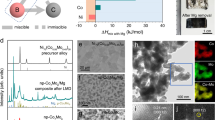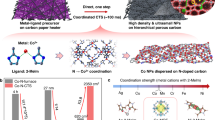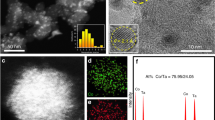Abstract
Shape- and size-controlled supported metal and intermetallic nanocrystallites are of increasing interest because of their catalytic and electrocatalytic properties. In particular, intermetallics PtX (X = Bi, Pb, Pd, Ru) are very attractive because of their high activity as fuel-cell anode catalysts for formic acid or methanol oxidation. These are normally synthesized using high-temperature techniques, but rigorous size control is very challenging. Even low-temperature techniques typically produce nanoparticles with dimensions much greater than the optimum <6 nm required for fuel cell catalysis. Here, we present a simple and robust, chemically controlled process for synthesizing size-controlled noble metal or bimetallic nanocrystallites embedded within the porous structure of ordered mesoporous carbon (OMC). By using surface-modified ordered mesoporous carbon to trap the metal precursors, nanocrystallites are formed with monodisperse sizes as low as 1.5 nm, which can be tuned up to ∼3.5 nm. To the best of our knowledge, 3-nm ordered mesoporous carbon-supported PtBi nanoparticles exhibit the highest mass activity for formic acid oxidation reported to date, and over double that of Pt–Au.
This is a preview of subscription content, access via your institution
Access options
Subscribe to this journal
Receive 12 print issues and online access
$259.00 per year
only $21.58 per issue
Buy this article
- Purchase on Springer Link
- Instant access to full article PDF
Prices may be subject to local taxes which are calculated during checkout






Similar content being viewed by others
References
Weber, M., Wang, J. T., Wasmus, S. & Savinell, R. F. Formic acid oxidation in a polymer electrolyte fuel cell. J. Electrochem. Soc. 143, L158–L160 (1996).
Rice, C. et al. Direct formic acid fuel cells. J. Power Sources 111, 83–89 (2002).
Rhee, Y.-W., Ha, S. Y. & Masel, R. I. Crossover of formic acid through Nafion® membranes. J. Power Sources 117, 35–38 (2003).
Park, S., Xie, Y. & Weaver, M. J. Electrocatalytic pathways on carbon-supported platinum nanoparticles: comparison of particle-size-dependent rates of methanol, formic acid, and formaldehyde electrooxidation. Langmuir 18, 5792–5798 (2002).
Lović, J. D. et al. Kinetic study of formic acid oxidation on carbon-supported platinum electrocatalyst. J. Electroanal. Chem. 581, 294–302 (2005).
Capon, A. & Parsons, R. J. The oxidation of formic acid at noble metal electrodes. Part III. Intermediates and mechanism on platinum electrodes. Electroanal. Chem. 45, 205–231 (1973).
Wolter, O., Willsau, J. & Heitbaum, J. Reaction pathways of the anodic oxidation of formic acid on Pt evidenced by 18O labeling—a DEMS study. J. Electrochem. Soc. 132, 1635–1638 (1985).
Sun, S. G. & Clavilier, J. The mechanism of electrocatalytic oxidation of formic acid on Pt (100) and Pt (111) in sulphuric acid solution: an emirs study. J. Electroanal. Chem. 240, 147–159 (1988).
Chang, S.-C., Ho, Y. & Weaver, M. J. Applications of real-time infrared spectroscopy to electrocatalysis at bimetallic surfaces: I. Electrooxidation of formic acid and methanol on bismuth-modified Pt(111) and Pt(100). Surf. Sci. 265, 81–94 (1992).
Llorca, M. J., Herrero, E., Feliu, J. M. & Aldaz, A. Formic acid oxidation on Pt(111) electrodes modified by irreversibly adsorbed selenium. J. Electroanal. Chem. 373, 217–225 (1994).
Leiva, E., Iwasita, T., Herrero, E. & Feliu, J. M. Effect of adatoms in the electrocatalysis of HCOOH oxidation. A theoretical model. Langmuir 13, 6287–6293 (1997).
Smith, S. P. E. & Abruña, H. D. Structural effects on the oxidation of HCOOH by bismuth modified Pt(111) electrodes with (110) monatomic steps. J. Electroanal. Chem. 467, 43–49 (1999).
Schmidt, T. J. & Behm, R. J. Formic acid oxidation on pure and Bi-modified Pt(111): temperature effects. Langmuir 16, 8159–8166 (2000).
Spendelow, J. S. & Wieckowski, A. Noble metal decoration of single crystal platinum surfaces to create well-defined bimetallic electrocatalysts. Phys. Chem. Chem. Phys. 6, 5094–5118 (2004).
Casado-Rivera, E. et al. Electrocatalytic oxidation of formic acid at an ordered intermetallic PtBi surface. ChemPhysChem. 4, 193–199 (2003).
Casado-Rivera, E. et al. Electrocatalytic activity of ordered intermetallic phases for fuel cell applications. J. Am. Chem. Soc. 126, 4043–4049 (2004).
Rice, C., Ha, S., Masel, R. I. & Wieckowski, A. Catalysts for direct formic acid fuel cells. J. Power Sources 115, 229–235 (2003).
Roychowdhury, C., Matsumoto, F., Mutolo, P. F., Abruña, H. D. & DiSalvo, F. J. Synthesis, characterization, and electrocatalytic activity of PtBi nanoparticles prepared by the polyol process. Chem. Mater. 17, 5871–5876 (2005).
Roychowdhury, C. et al. Synthesis, characterization, and electrocatalytic activity of PtBi and PtPb nanoparticles prepared by borohydride reduction in methanol. Chem. Mater. 18, 3365–3372 (2006).
Matsumoto, F., Roychowdhury, C., DiSalvo, F. J. & Abruña, H. D. Electrocatalytic activity of ordered intermetallic PtPb nanoparticles prepared by borohydride reduction toward formic acid oxidation. J. Electrochem. Soc. 155, B148–B154 (2008).
Bauer, J. C., Chen, X., Liu, Q., Phan, T.-H. & Schaak, R. E. Converting nanocrystalline metals into alloys and intermetallic compounds for applications in catalysis. J. Mater. Chem. 18, 275–282 (2008).
Chan, K.-Y., Ding, J., Ren, J., Cheng, S. & Tsang, K. Y. Supported mixed metal nanoparticles as electrocatalysts in low temperature fuel cells. J. Mater. Chem. 14, 505–516 (2004).
Ryoo, R., Joo, S. H. & Jun, S. Synthesis of highly ordered carbon molecular sieves via template-mediated structural transformation. J. Phys. Chem. B 103, 7743–7746 (1999).
Joo, S. et al. Ordered nanoporous arrays of carbon supporting high dispersions of platinum nanoparticles. Nature 412, 169–172 (2001).
Joo, J. B., Kim, P., Kim, W., Kim, J. & Yi, J. Preparation of mesoporous carbon templated by silica particles for use as a catalyst support in polymer electrolyte membrane fuel cells. Catal. Today 111, 171–175 (2006).
Nam, J.-H., Jang, Y.-Y., Kwon, Y.-U. & Nam, J.-D. Direct methanol fuel cell Pt–carbon catalysts by using SBA-15 nanoporous templates. Electrochem. Commun. 6, 737–741 (2004).
Yu, J.-S., Kang, S., Yoon, S. B. & Chai, G. Fabrication of ordered uniform porous carbon networks and their application to a catalyst supporter. J. Am. Chem. Soc. 124, 9382–9383 (2002).
Liu, H. et al. A review of anode catalysis in the direct methanol fuel cell. J. Power Sources 155, 95–110 (2006).
Li, Z., Yan, W. & Dai, S. Surface functionalization of ordered mesoporous carbons—a comparative study. Langmuir 21, 11999–12006 (2005).
Guo, Z. et al. Adsorption of vitamin B12 on ordered mesoporous carbons coated with PMMA. Carbon 43, 2344–2351 (2005).
Calvillo, L. et al. Platinum supported on functionalized ordered mesoporous carbon as electrocatalyst for direct methanol fuel cells. J. Power Sources 169, 59–64 (2007).
Choi, W. et al. Platinum nanoclusters studded in the microporous nanowalls of ordered mesoporous carbon. Adv. Mater. 17, 446–451 (2005).
Wen, Z., Liu, J. & Li, J. Core/shell Pt/C nanoparticles embedded in mesoporous carbon as a methanol-tolerant cathode catalyst in direct methanol fuel cells. Adv. Mater. 20, 743–747 (2008).
Liu, S. et al. Fabrication and characterization of well-dispersed and highly stable PtRu nanoparticles on carbon mesoporous material for applications in direct methanol fuel cell. Chem. Mater. 20, 1622–1628 (2008).
Orilall, M. C. et al. One-pot synthesis of platinum-based nanoparticles incorporated into mesoporous niobium oxide-carbon composites for fuel cell electrodes. J. Am. Chem. Soc. 131, 9389–9395 (2009).
Zhu, Y., Kockrick, E., Kaskel, S., Ikoma, T. & Hanagata, N. Nanocasting route to ordered mesoporous carbon with FePt nanoparticles and its phenol adsorption property. J. Phys. Chem. C 113, 5998–6002 (2009).
Jun, S. et al. Synthesis of new, nanoporous carbon with hexagonally ordered mesostructure. J. Am. Chem. Soc. 122, 10712–10713 (2000).
Chen, I. Molecular-orbital studies of charge carrier transport in orthorhombic sulfur. I. Molecular orbitals of S8 . Phys. Rev. B 2, 1053–1060 (1970).
Miller, J. T. & Koningsbergery, D. C. The origin of sulfur tolerance in supported platinum catalysts: the relationship between structural and catalytic properties in acidic and alkaline Pt/LTL. J. Catal. 162, 209–219 (1996).
Ji, X., Lee, K. T. & Nazar, L. F. A highly ordered nanostructured carbon–sulphur cathode for lithium–sulphur batteries. Nat. Mater. 8, 500–506 (2009).
Zhuravlev, N. N. & Stepanova, A. A. An X-ray investigation of superconducting alloys of bismuth with platinum in the range of 20–640 °C. Sov. Phys.-Crystallogr. 7, 231–242 (1962).
Blasini, D. R. et al. Surface composition of ordered intermetallic compounds PtBi and PtPb. Surf. Sci. 600, 2670–2680 (2006).
Zhou, W. P. et al. Size effects in electronic and catalytic properties of unsupported palladium nanoparticles in electrooxidation of formic acid. J. Phys. Chem. B 110, 13393–13398 (2006).
Ge, J. et al. Controllable synthesis of Pd nanocatalysts for direct formic acid fuel cell (DFAFC) application: from Pd hollow nanospheres to Pd nanoparticles. J. Phys. Chem. C 111, 17305–17310 (2007).
Kristian, N., Yanb, Y. & Wang, X. Highly efficient submonolayer Pt-decorated Au nano-catalysts for formic acid oxidation. Chem. Commun. 353–355 (2008).
Xu, J. B., Zhao, T. S. & Liang, Z. X. Synthesis of active platinum–silver alloy electrocatalyst toward the formic acid oxidation reaction. J. Phys. Chem. C 112, 7362–7368 (2008).
Tian, N., Zhou, Z., Sun, S., Ding, Y. & Wang, Z. Synthesis of tetrahexahedral platinum nanocrystals with high-index facets and high electro-oxidation activity. Science 316, 732–735 (2007).
Rigsby, M. A. et al. Experiment and theory of fuel cell catalysis: methanol and formic acid decomposition on nanoparticle Pt/Ru. J. Phys. Chem. C 112, 15595–15601 (2008).
Huang, Y. et al. Preparation of Pd/C catalyst for formic acid oxidation usinga novel colloid method. Electrochem. Commun. 10, 621–624 (2008).
Yu, X. & Pickup, P. G. Recent advances in direct formic acid fuel cells (DFAFC). J. Power Sources 182, 124–132 (2008).
Acknowledgements
L.F.N. gratefully acknowledges the financial support of the National Science and Engineering Research Council (NSERC, Canada) through its Discovery Grant and Canada Research Chair programs. We thank R. Sodhi at Surface Interface Ontario, University of Toronto, for acquisition and processing of the XPS spectra and C. Mims for helpful discussions, N. Coombs at the Centre for Nanostructured Imaging, University of Toronto, for help with acquisition of the STEM imaging, and C. Andrei (McMaster University, Canadian Centre for Electron Microscopy) for help with the high-resolution imaging work. The experimental work on the FEI Titan 80–300 and FEI Titan 80–300 Cubed was carried out at the Canadian Centre for Electron Microscopy, a user facility supported by NSERC and McMaster University.
Author information
Authors and Affiliations
Contributions
X.J. and L.N. designed and conducted the research. Electrochemical experiments were performed by X.J., L.Z., and J.Z. K.L. and R.H. contributed analysis. TEM experiments were performed by G.B. and M.C. L.N. and X.J. wrote the paper.
Corresponding author
Ethics declarations
Competing interests
The authors declare no competing financial interests.
Supplementary information
Supplementary information
Supplementary information (PDF 4852 kb)
Rights and permissions
About this article
Cite this article
Ji, X., Lee, K., Holden, R. et al. Nanocrystalline intermetallics on mesoporous carbon for direct formic acid fuel cell anodes. Nature Chem 2, 286–293 (2010). https://doi.org/10.1038/nchem.553
Received:
Accepted:
Published:
Issue Date:
DOI: https://doi.org/10.1038/nchem.553
This article is cited by
-
Polysulfide modified PtCu intermetallic nanocatalyst with enrichment realizes efficient electrooxidation ethanol to CO2
Nano Research (2023)
-
GaN nanowires/Si photocathodes for CO2 reduction towards solar fuels and chemicals: advances, challenges, and prospects
Science China Chemistry (2023)
-
Fabrication of 3D hollow acorn-shell-like PtBi intermetallics via a surfactant-free pathway for efficient ethylene glycol electrooxidation
Nano Research (2023)
-
Facile synthesis of PdCu nanocluster-assembled granular films as highly efficient electrocatalysts for formic acid oxidation
Rare Metals (2022)
-
Low-coordinated surface sites make truncated Pd tetrahedrons as robust ORR electrocatalysts outperforming Pt for DMFC devices
Nano Research (2022)



